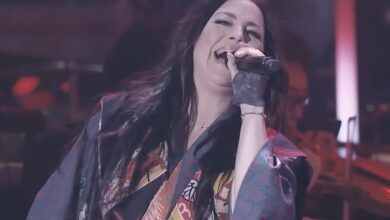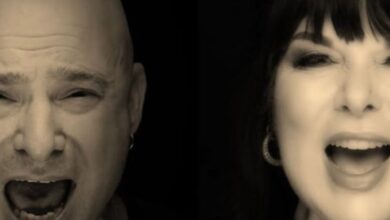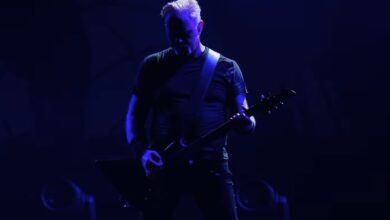Metallica Unleashes “Enter Sandman” Before 1.6 Million in Moscow—A Live Moment That Shook the World
Metallica’s performance of “Enter Sandman” during the Monsters of Rock festival at Tushino Airfield in Moscow on September 28, 1991, was a defining moment in rock history. Coming just weeks after the failed August coup, this free concert became a symbol of newfound freedom and cultural exchange. As the ominous opening riff reverberated across the vast field, what began as a local rock showcase became a global cultural phenomenon, setting the tone for one of the most electrifying nights of the era.
James Hetfield stepped onto a massive stage under open skies, the distinctive five-note lullaby riff echoing like a thunderclap. Backed by Lars Ulrich’s tight, explosive drumming and Kirk Hammett’s swirling lead lines, the band delivered a performance that transcended mere entertainment. Hetfield’s voice channeled both menace and melody, transforming a hard rock anthem into a collective experience. The crowd’s roar was deafening—hundreds of thousands singing along, their voices merging with the band’s, creating a moment of shared musical communion.
On that raw September day, the scale of the event was staggering—official figures reported upwards of half a million attendees, with unofficial estimates claiming over a million people had flooded onto the airfield. It wasn’t just a concert—it was a movement. Security guards and Red Army soldiers lined the stage to maintain order, but order hardly described the torrent of emotion in the crowd. The sense of release, rebellion, and unity was palpable, as music became a reckoning force against decades of isolation.
Metallica was fresh off the release of The Black Album, and “Enter Sandman” had already climbed the charts worldwide. The tune’s success extended beyond album sales—it became an anthem of a shifting world. Here in Moscow, the American heavy metal soundtrack intersected with Russia’s turning point, amplified by the literal presence of Western bands. Metallica’s riff-heavy sound clashed thrillingly with the backdrop of Soviet icons, creating an electric contrast.
The performance wasn’t just historic—it was theatrical. As the main riff dropped and the chorus thundered, the crowd’s response was immediate and almost tribal. Hetfield paced the stage with swagger, his voice projecting defiance and power. Hammett unleashed searing solos that rose above the roar like a beacon. Ulrich’s pounding drums echoed like cannon fire, making the ground pulse beneath everyone’s feet. Metallica had always embraced spectacle, but that Moscow night elevated it to cultural catharsis.
In the midst of the set, Lars Ulrich fractured a drumstick and injured his hand during the set. Blood was visible on the skin and drum kit, a visceral reminder of the rawness of live performance. It was as if the band was bleeding emotion right alongside the crowd’s fervor. For many in the audience, witnessing an almost-bleeding drummer under the Russian sky made the moment feel more alive, more real.
Security was both intense and chaotic. Accounts describe Red Army troops standing guard near the stage, while private security and local police attempted to maintain control in the sprawling mass. Concertgoers remembered pushes, shoves, and close calls—figures suggest dozens were hospitalized and dozens more detained. Yet amidst the chaos lurked a kind of rough-hewn energy that mirrored the broader societal upheaval. The concert’s nickname, “Tushino Massacre,” captured both the violence and the vitality.
The setlist included more than “Enter Sandman,” but when the riff kicked in, the night locked in. Song after song—“Creeping Death,” “Fade to Black,” “Sad but True”—the band and crowd carried each other through waves of adrenaline and nostalgia. The Helsinki-born festival crowd knew every word, every pause, every guitar bend. Moscow had found its rock voice that night, and Metallica was its megaphone.
The moment was captured on film by director Wayne Isham, later released as the documentary Monsters of Rock in Moscow. The footage was grainy, raw, and filled with the intensity of the crowd pressed close to the stage. Within months, the VHS release became a sought-after artifact of rock reawakening. It was a document of history, a time capsule that would travel the world long after the airfield had emptied.
In live albums and retrospectives like Live Shit: Binge & Purge, Metallica’s Moscow set gained legendary status. This performance became part of the band’s mythos—a milestone not only in their career but in modern rock lore. It’s a moment referenced by fans and critics alike, a benchmark for how music can both reflect and inspire societal change.
Kirk Hammett later recalled in interviews that he drew inspiration from bands like Soundgarden for the main riff, which he then refined under Bob Rock’s production on The Black Album. The Moscow show, therefore, wasn’t just performance—it was proof that careful songwriting and hard touring could collide with historical momentum to produce moments of musical transcendence.
“Enter Sandman” became a fixture at sports events and films, its riff anchored in popular culture. But in Moscow, that riff echoed through history, perhaps louder than anywhere else. The idea of freedom collided with heavy metal, rock rhythms pulsed through a city renewing itself. For many fans, the memory of that riff launched into the sky feels eternal.
After that night, Metallica returned home and continued on the Wherever We May Roam tour, the momentum from Moscow fueling sold-out stadiums and international acclaim. Their Black Album became their best-selling record, while “Enter Sandman” remained a staple in their setlists. Yet it was the Tushino show that became the emotional fulcrum of their career: a visceral reminder that rock is both art and uprising.
Today, fans still discover this concert via YouTube, often marveling at the scale, the atmosphere, and the energy. Clips from performances like “Enter Sandman” in Moscow reveal not just tight musicianship but a shared human moment—a crowd pushed to the brink of euphoria, and a band delivering their soul in return. It’s rare, almost sacred: a moment of unity in a world of turmoil.
The Tushino Airfield show stands as a testament to rock’s power, and to Metallica’s role in it. Coming at the tail end of the Soviet era, it was louder than censorship, louder than walls, and louder than doubt. Today, it remains a reminder that when conditions converge, music doesn’t just entertain—it resonates across history.
Over thirty years later, the riff still sends a chill. Generations of Metallica fans post clips and reactions, praising the band’s endurance and the crowd’s raw presence. What began as a gig in Moscow became legend: a storm of sound, blood, and unity under open skies—a once-in-a-lifetime collision of riffs and revolutions.





